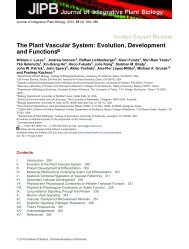Hacke et al-2007.pdf - Herve Cochard
Hacke et al-2007.pdf - Herve Cochard
Hacke et al-2007.pdf - Herve Cochard
Create successful ePaper yourself
Turn your PDF publications into a flip-book with our unique Google optimized e-Paper software.
1122 INTERNATIONAL JOURNAL OF PLANT SCIENCES<br />
In contrast, pit membranes from the species with the highest<br />
pit resistance, Drimys granadensis, had relatively sm<strong>al</strong>l pores<br />
(rP ¼ 42 6 9:9 MPa s m 1 ; fig. 5E). By comparison, pores<br />
are often not visible in the SEM for intervessel pit membranes<br />
of many vessel-bearing species such as Trimenia neoc<strong>al</strong>edonica<br />
(fig. 5F). Not fitting this correspondence b<strong>et</strong>ween<br />
observed porosity and pit resistance was Zygogynum pancherii,<br />
which had relatively low pit resistance (rP ¼ 23:5 6 5:6 MPas<br />
m 1 ; fig. 4) but barely visible membrane pores (fig. 5D).<br />
The silicone injections <strong>al</strong>so provided indirect evidence for<br />
relatively large pores in intertracheid pit membranes of at least<br />
some of the vesselless species (fig. 6). When the red pigment<br />
of large particle size (0:60 6 0:11 mm)wasusedwithsilicone,<br />
mean tracheid length was similar wh<strong>et</strong>her c<strong>al</strong>culated from<br />
the injections or measured directly from macerations (fig. 6,<br />
open circles; regression not different from 1 : 1 line). However,<br />
when the soluble Uvitex dye was used, mean tracheid<br />
length measured by injection exceeded the maceration measurement<br />
in sever<strong>al</strong> species, especi<strong>al</strong>ly so in A. trichopoda,<br />
Bubbia queenslandiana, Zygogynum baillonii, Tasmannia membranea,<br />
and Zygogynum bicolor (fig. 6, filled circles, abbreviations).<br />
On average, the mean tracheid length from the<br />
silicone/Uvitex injection was 1:5 6 0:1 times longer than the<br />
mean from macerations, ranging from just over 1.0 in sever<strong>al</strong><br />
species to a high of 2.9 in A. trichopoda.<br />
Vulnerability curves of the vesselless taxa were very similar<br />
in shape: a sigmoid<strong>al</strong> relationship with a well-defined cavitation<br />
threshold (fig. 7). However, there was considerable variation<br />
in the mean cavitation pressure, ranging from 1:5 6 0:1<br />
MPa in T. sinense to 5:5 6 0:2 MPainP. traversii. The grand<br />
mean for <strong>al</strong>l species was 3:4 6 0:3 MPa, indicating a surprising<br />
degree of protection from cavitation, given their gener<strong>al</strong>ly<br />
w<strong>et</strong> and often shaded habitats (table 1). The north<br />
Fig. 6 Conduit lengths measured by the silicone-injection m<strong>et</strong>hod<br />
versus by the maceration m<strong>et</strong>hod. Solid line is 1 : 1 agreement. Data<br />
points are species means 6 SE, non-log-transformed. In five species,<br />
the silicone contained a red pigment whose average particle size of<br />
ca. 0.6 mm inhibited pen<strong>et</strong>ration through porous intertracheid pit<br />
membranes (open symbols). All but one of these species, plus the<br />
remaining ones, were reinjected with silicone plus soluble Uvitex<br />
fluorescent dye (filled symbols). Species abbreviations from table 1.<br />
Fig. 7 Vulnerability-to-cavitation curves for vesselless taxa showing<br />
percentage loss of conductivity as a function of negative pressure.<br />
Curves are means 6 SE for six stems per species. Symbols are identified<br />
from most vulnerable (top right, open symbols) to increasingly<br />
resistant (left, from top to bottom, gray and black symbols). Species<br />
abbreviations from table 1.<br />
Queensland population of Tasmannia insipida is not shown<br />
but was very similar to the New South W<strong>al</strong>es population for<br />
the first h<strong>al</strong>f of the vulnerability curve (up to 50% loss of<br />
conductivity). However, beyond this point, the xylem was<br />
much more resistant. Because of the very different curve for<br />
this apparently disjunct Queensland population, we did not<br />
use it in further an<strong>al</strong>ysis but represented the cavitation resistance<br />
of the species with the New South W<strong>al</strong>es data.<br />
Over<strong>al</strong>l, the threshold cavitation pressure compared favorably<br />
with the threshold air-entry pressure for the air-injected<br />
species (fig. 8; regression confidence limits include 1 : 1 line),<br />
supporting the hypothesis that air entry through pit membranes<br />
was causing the cavitation. Species furthest from agreement<br />
were P. traversii and T. ar<strong>al</strong>ioides, where the average air-entry<br />
pressure was less than the cavitation threshold, and B. queenslandiana,<br />
which showed the opposite situation (fig. 8).<br />
The vesselless angiosperms did appear to follow the pit<br />
area hypothesis but not in the simple way expected from the<br />
published eudicot data (fig. 9; <strong>Hacke</strong> <strong>et</strong> <strong>al</strong>. 2006). The vesselless<br />
taxa were consistent with the hypothesis because there<br />
was a significant relationship b<strong>et</strong>ween increasing interconduit<br />
pit area (AP* from silicone length data) and increasing vulnerability<br />
to cavitation. The slope of the log-log relationship<br />
( 1:30 6 0:33) was no different from that of the eudicot data<br />
( 1:92 6 0:20). Using the pit area estimated from macerations<br />
(AP instead of AP*) <strong>al</strong>so gave a significant relationship<br />
(r 2 ¼ 0:45; data not shown), with a similar slope. Notably, the<br />
vesselless taxa had substanti<strong>al</strong>ly less tot<strong>al</strong> pit area per conduit<br />
for the same cavitation pressure than eudicot taxa (fig. 9).<br />
This is consistent with intertracheid pits having more porous<br />
membranes than intervessel pits (see ‘‘Discussion’’).<br />
There was evidence of a trade-off b<strong>et</strong>ween increasing resistance<br />
to cavitation and increasing sapwood area resistivity<br />
(r 2 ¼ 0:28) and a significant trend (r 2 ¼ 0:27; data not shown)<br />
for narrower tracheids to be more resistant to cavitation. We<br />
<strong>al</strong>so found a relationship b<strong>et</strong>ween greater wood density and
















